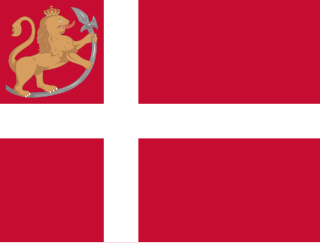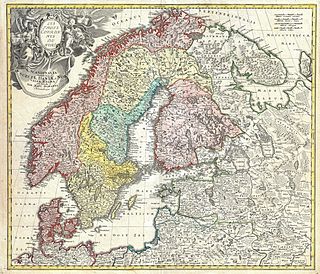
Charles XIV and III John or Carl John, was King of Sweden and King of Norway from 1818 until his death, and served as de facto regent and head of state from 1810 to 1818. He was also the Sovereign Prince of Pontecorvo, in south-central Italy, from 1806 until 1810.
This is a History of Sweden from 1772 through 1809, more known as the Gustavian era of Kings Gustav III and Gustav IV, as well as the reign of King Charles XIII of Sweden.

Sweden and Norway or Sweden–Norway, officially the United Kingdoms of Sweden and Norway, or as the United Kingdoms, was a personal union of the separate kingdoms of Sweden and Norway under a common monarch and common foreign policy that lasted from 1814 until its amicable and peaceful dissolution in 1905.

The Napoleonic era is a period in the history of France and Europe. It is generally classified as including the fourth and final stage of the French Revolution, the first being the National Assembly, the second being the Legislative Assembly, and the third being the Directory. The Napoleonic era begins roughly with Napoleon Bonaparte's coup d'état, overthrowing the Directory, establishing the French Consulate, and ends during the Hundred Days and his defeat at the Battle of Waterloo. The Congress of Vienna soon set out to restore Europe to pre-French Revolution days. Napoleon brought political stability to a land torn by revolution and war. He made peace with the Roman Catholic Church and reversed the most radical religious policies of the Convention. In 1804 Napoleon promulgated the Civil Code, a revised body of civil law, which also helped stabilize French society. The Civil Code affirmed the political and legal equality of all adult men and established a merit-based society in which individuals advanced in education and employment because of talent rather than birth or social standing. The Civil Code confirmed many of the moderate revolutionary policies of the National Assembly but retracted measures passed by the more radical Convention. The code restored patriarchal authority in the family, for example, by making women and children subservient to male heads of households.

The Franco-Swedish War or Pomeranian War was the first involvement by Sweden in the Napoleonic Wars. The country joined the Third Coalition in an effort to defeat France under Napoleon Bonaparte.

In the War of the Sixth Coalition, sometimes known in Germany as the War of Liberation, a coalition of Austria, Prussia, Russia, the United Kingdom, Portugal, Sweden, Spain and a number of German States defeated France and drove Napoleon into exile on Elba. After the disastrous French invasion of Russia of 1812, the continental powers joined Russia, the United Kingdom, Portugal and the rebels in Spain who were already at war with France.

The Treaty of Kiel or Peace of Kiel was concluded between the United Kingdom of Great Britain and Ireland and the Kingdom of Sweden on one side and the Kingdoms of Denmark and Norway on the other side on 14 January 1814 in Kiel. It ended the hostilities between the parties in the ongoing Napoleonic Wars, where the United Kingdom and Sweden were part of the anti-French camp while Denmark–Norway was allied to Napoleon Bonaparte.

During the Napoleonic Wars, the Anglo-Russian War was the phase of hostilities between the United Kingdom and Russia after the latter signed the Treaty of Tilsit that ended its war with France. Anglo-Russian hostilities were limited primarily to minor naval actions in the Baltic and Barents Seas.

In August 1814, after a loss in the Swedish–Norwegian War, Kingdom of Norway was forced to join in a personal union with Kingdom of Sweden, thereby becoming subject to a naval blockade by the British Empire, but remaining largely autonomous within the union. Although nationalist aspirations were not to be fully realized until the events of 1905, 1814 was the crisis and turning point in events that would lead to a fully independent Norway.

The history of Scandinavia is the history of the geographical region of Scandinavia and its peoples. The region is in northern Europe, and consists of Denmark, Norway, and Sweden. Finland and Iceland are at times, especially in English-speaking contexts, considered part of Scandinavia.

Charles August or Carl August was a Danish prince. He is best known for serving as Crown Prince of Sweden briefly in 1810, adopted by Charles XIII, before his sudden death from stroke. Earlier, he had been a general in the Royal Danish Army as well as the Danish Governor-general of Norway. His name before assuming the Swedish title in 1810 was Christian August of Schleswig-Holstein-Sonderburg-Augustenborg; Christian August of Augustenborg for short.

British–Danish relations are foreign relations between the United Kingdom and Denmark. The United Kingdom has an embassy in Copenhagen and Denmark has an embassy in London. Both countries are full members of NATO and of the European Union, although the United Kingdom plans to leave the European Union.

Denmark–France relations refers to the current and historical relations between Denmark and France. Denmark has an embassy in Paris and France has an embassy in Copenhagen. Both countries are full members of NATO and of the European Union.

The English Wars were a series of conflicts between England and Sweden with Denmark-Norway as part of the Napoleonic Wars. It is named after the most prominent region of its other main participant, the United Kingdom, which declared war on Denmark-Norway due to disagreements over the neutrality of Danish trade and to prevent the Danish fleet falling into the hands of the First French Empire. It began with the first battle of Copenhagen in 1801 and its latter stage from 1807 onwards was followed by the Gunboat War, the Dano-Swedish War of 1808-1809 and the Swedish invasion of Holstein in 1814.

The Union between Sweden and Norway is an overriding theme of the history of Sweden in the 19th century. On 4 November 1814, the kingdoms of Sweden and Norway formed a personal union under one king. The two countries had completely separate institutions, except for the foreign service led by the king through the Swedish foreign minister.

The Dano–Swedish War of 1808–1809 was a war between Denmark–Norway and Sweden due to Denmark–Norway's alliance with France and Sweden's alliance with the United Kingdom during the Napoleonic Wars. Neither Sweden nor Denmark-Norway had wanted war to begin with but once pushed into it through their respective alliances, Sweden made a bid to acquire Norway by way of invasion while Denmark-Norway made ill-fated attempts to reconquer territories lost to Sweden in the 17th century. Peace was concluded on grounds of status quo ante bellum on 10 December 1809.






















